Vamobility: High-Speed Rail, Revisited.📌📌
Vamobility: Previews & Reviews of Modes & Means (Premise).
California Speedin’.
(Update: 12/9/23)—As go politics and pump prices, so goes US high-speed rail…
No better example of this precarious, often inverse relationship exists than the nation’s largest, most ambitious HSR project, playing out in California—which incidentally just received a fresh $6bn seeding from the federal government to speed up construction of the bullet rail lines, courtesy of the Biden Administration’s 2022 infrastructure law. This ‘manna’ from Washington follows a September award of $202m for HSR system buildout in Kern County.
Now a $3bn grant to the state’s High-Speed Rail Authority is earmarked for completing construction on the nearly 120-mile leg of the Central Valley route between Merced and Bakersfield, including a rail link 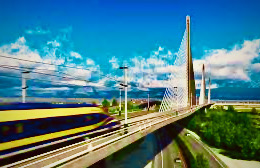 from Merced to Fresno’s planned new downtown station. The Valley stretch is scheduled to open (with five stations) between 2030 and 2033. This federal funding will also cover six new high-tech electric trains.
from Merced to Fresno’s planned new downtown station. The Valley stretch is scheduled to open (with five stations) between 2030 and 2033. This federal funding will also cover six new high-tech electric trains.
The remaining $3bn goes to Brightline West,☟a Florida-born HSR system that will link Los Angeles and Las Vegas via a bullet train running at 186 m.p.h.. That private-sector line is on track to operate by LA’s Summer Olympics/2028.
Otherwise, a 380-mile+ line from San Francisco to Los Angeles, projected for completion by 2033, remains a bit more problematic, funding wise. This downtown-to-downtown route was touted as a remedy for airport and highway congestion, loping major time and 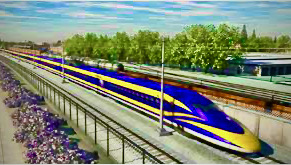 hassles off the NorCal-SoCal trip for business and leisure, at over 200 m.p.h. clip.
hassles off the NorCal-SoCal trip for business and leisure, at over 200 m.p.h. clip.
No delays, security line strip-downs, gas price enslavement or various air/highway hazards: Bullet train service in Japan and throughout Europe has already proven to be their statistically safest mode of transportation over 30 years of regular high-speed operation.
HSR proponents also cite stretch-out riding comfort, relative energy savings (‘greenest form of transportation, powered 100% by renewables’), and the developmental/ancillary economic boon to towns and cities along the line.
So, all aboard, what’s not to like, right? Well, not so fast quite yet, as speed bumps abound…
Valley Forged?
10/15/22—‘Starter’ line or stop sign: Is California’s super-hyped, initial US high-speed rail project derailing or cannonballing along?
To backtrack: First voter approved in 2008, the state’s groundbreaking HSR ‘Bullet’ project was envisioned as whisking passengers from between San Francisco and Los Angeles at 110-220 m.p.h. in under three hours—making it one of the world’s fastest trains. Ostensibly, the speedliner’s most direct route would have been along the I-5 corridor, through the Tejon Pass ‘Grapevine’, descending the steep mountains of Southern California into metro L.A.—with eventual extensions to Sacramento and San Diego, The estimated price tag for easing the state’s smoggy skies: $33bn with a 2020 completion target.
Only then the project’s Phase One course soon became sidetracked due to something of a political correction, based on neither technical nor fiscal factors so much as pure horse-trading pressure and persuasion. Granted, the Grapevine route would have required magic bullet engineering and costly land acquisition, but state and local politicos tilted the initial ‘cannonball’ itinerary eastward on decidedly pork barrel grounds. Soon came diversions through Mojave Desert suburbs, a 41-mile dogleg to Lancaster and Palmdale—ostensibly serving more passengers, yet further distending travel time: the fruits of land developers, campaign contributors and legislators (state/local) to be sure.
Dodging the Bullet?
Before long, these outlying detours led to California’s heartland, the Central Valley—duly championed earlier on by the Gov. Jerry Brown and Barak Obama administrations—with even more funding grants ($3.5 bn+), huge construction contracts and popular votes firmly on track.
How green was the Valley? Good for business, jobs, for added ridership and farmers selling flatter, 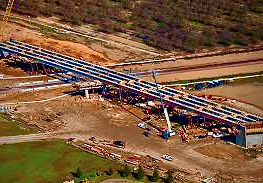 comparatively cheaper land: HSR’s valley stretch was such a fat political plum that the California High-Speed Rail Authority was compelled to forge a tranched 171-mile “starter” line mid state in 2008. The compromise plan was to eventually connect growing cities the likes of Merced, Fresno and Bakersfield instead of beginning construction at either of the original megaregional hubs—where far more of the potential passengers are, after all—with a stated completion date of sometime in 2030, according to CHSRA’s latest business plan.
comparatively cheaper land: HSR’s valley stretch was such a fat political plum that the California High-Speed Rail Authority was compelled to forge a tranched 171-mile “starter” line mid state in 2008. The compromise plan was to eventually connect growing cities the likes of Merced, Fresno and Bakersfield instead of beginning construction at either of the original megaregional hubs—where far more of the potential passengers are, after all—with a stated completion date of sometime in 2030, according to CHSRA’s latest business plan.
State of the Start.
So, happy valley? Rather, that hope-against-hope HSR completion quote has been throttled down by hopeless, runaway bloat: namely increased travel time and ever rising costs. The Central Valley ‘siding’ was a wasteful non-starter, said one former rail authority chairman; another concludes that the system (would) be running by now, but for the bad political decisions. “…As a consequence, the system (may) never be operable,” says a former head of the nonprofit California Rail Foundation. Even a Fresno developer who now chairs the Authority admits that different choices would be made today, as though the added valley passengers weren’t worth the further delays.
In any case, Starter Line construction costs on the initial CP1 Madera-Fresno segment (due 2023) are now about $1.8m per diem, on a California dream project that has already burned through billions of dollars, and is projected to tote a $113bn+ price tag. Plowing forward, HSR will likely have to power up cost controls and find yet new funding sources—the Joe Biden administration’s trillion-dollar infrastructure initiative notwithstanding—if the Golden State’s high-speedballers are ever to actually ride the rails.
Some HSR watchers conclude that the elongated 380-mile, 24 station system serving six of California’s 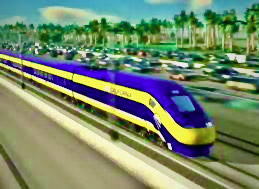 10 largest cities would have been better served by laying shorter ‘beta test’ track between between Los Angeles and San Diego. Critics rail that if the original vision was to speed L.A. and San Francisco passengers along at a 2 hour 40 minute clip, providing a renewable electric alternative to today’s carbon fouled, congested skies and freeways, what sense did it make to turn an sleek express train into a local chugalong ‘forgery’?
10 largest cities would have been better served by laying shorter ‘beta test’ track between between Los Angeles and San Diego. Critics rail that if the original vision was to speed L.A. and San Francisco passengers along at a 2 hour 40 minute clip, providing a renewable electric alternative to today’s carbon fouled, congested skies and freeways, what sense did it make to turn an sleek express train into a local chugalong ‘forgery’?
As in how are they going to keep HSR down on the farmland, when its passengers really seek to take a bullet to SF and L.A.? Of that, Vamigré will be keeping close track, but will not tote one thin US dime against high-speed rail over the long haul. (MTC…)
Boon…or Doggle?
10/18/21—Where to start? According to the High-Speed Rail Authority, California’s project off the drawing boards was to be funded by a triumvirate of state, federal governments and private business. Only government coffers are hitting uphill grades, and the private sector has yet to connect much at all.
By the numbers, California’s HSR plan carries a $1B price tag, but the authority has raised less than $30M to date, in the face of continually rising costs. Head Brian P. Kelly admits that, “we don’t have enough money to build what we want to build…fast, efficient service in a clean, economy expanding way.”
However, California voters approved a $9.95B bond a decade ago, which was to be down payment the HSR project—then pegged at $40B tops. So given the massive overruns, state-wide support for line completion has dropped to 31%. Opposition figures claim that the project makes little sense anymore, with a business plan that is more a “going-out-of-business plan” when factoring in land buys, construction costs overruns vs. projected benefit/profitability.
On the federal level, a Republican Congress and the Trump administration vigorously oppose the Golden State’s HSR project as a big government waste of money by blue-state Democrats—and doubt that it will ever be completed at all.
Still, 21 lengths of this HSR line are currently under construction in California’s Central Valley, a roughly 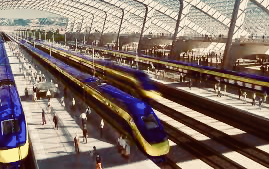 119-mile stretch of track from Madera down toward Bakersfield. Later links to the San Francisco Bay Area, and the prospect of tunneling through the Tehachapi Mountains to Los Angeles will be daunting, should the project ever get that far.
119-mile stretch of track from Madera down toward Bakersfield. Later links to the San Francisco Bay Area, and the prospect of tunneling through the Tehachapi Mountains to Los Angeles will be daunting, should the project ever get that far.
If not, land allotted, freeways and facilities moved, disconnected lengths of unfinished bridges, viaducts and railbeds will be virtually abandoned, likely for less visionary usage or demolition. This while the project is mired in developer design change orders and layer upon layer of managers and consultants.
Moreover, Central Valley farmers resist HSR gobbling up cropland and the resulting population overgrowth, maintaining the initial leg should have been routed along the Interstate-5 corridor, not Route 99. Add in disputes whether such a high-speed run between the San Francisco Bay Area and Los Angeles is even feasible as an alternative to crowded airplanes and freeway traffic, given an expected need for intermediate Valley rail stops.
Politically, the entire project had long been championed by Governor Jerry Brown. But it remains to be seen whether now Governor Gavin Newsom’s support, and public taxpayer funding, will be forthcoming and maintained from here on. Hard fact: no matter how far along, the bullet train’s plug could be pulled altogether at any time. Current budget projections total $80b for the Central Valley stretch alone, which has an extended deadline of 2022. (MMTC on all this…)
Update 2/6/20: High-Speed Crash, Italian Style.
![]() Two crew members died as a regional high-speed rail train derailed yesterday near the northern Italian city of Lodi.
Two crew members died as a regional high-speed rail train derailed yesterday near the northern Italian city of Lodi.
The Frecciarossa (Red Arrow) was traveling south from Milan to Salerno at over 180 m.p.h.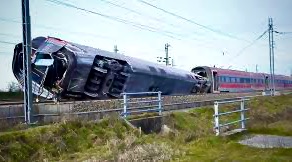 when it jumped the tracks about 25 miles from Milan. The train, Italy’s transportation pride, apparently struck a freight wagon on parallel tracks under maintenance, then careened into a nearby building.
when it jumped the tracks about 25 miles from Milan. The train, Italy’s transportation pride, apparently struck a freight wagon on parallel tracks under maintenance, then careened into a nearby building.
The engine and first carriage split from the remainder of the cars, both turning on their sides. Other than the forward cab drivers’ fatalities, some 30 passengers and crew escaped with minor injuries.
The entire Milan-Bologna route suspended operation and subsequent trains were diverted to lower speed lines until the Red Arrow’s wreckage could be cleared away. Preliminary reports point to driver error.![]()
Update: California’s High-Speed Derailleur.
Which is precisely what at has happened, at least partially. For as ambitious and promising as the Golden State’s HSR project has been, it has also run way over budget and behind schedule. And it now appears the San Francisco to Los Angeles leg has run out of time:
Taking the Bullet.
Tearing up the planned railed was fledgling governor, Gavin Newsom, via his first State of the State address on February 13.
His verdict on former Jerry Brown’s large legacy project: “Right now there isn’t a path to go from Sacramento to San Diego, let alone San Francisco to L.A..” The current effort, he declared, would cost too much, take too long.
Clearly, the 2008 bullet train business plan—initially bankrolled by that nearly $10b general obligation bond—was approved by 53% of California voters. But it had already been pushed back four years to 2033 completion, and its final price tag projection ballooned to $77b, losing statewide popularity, while gaining ‘hot box’ Republican resistance.
Dither and Yawn.
But here’s where the Newsom vision gets cloudier for the new governor. Accounting for construction for already underway, he vowed to continue building that Madera to Bakersfield HSR stretch—smack down the middle of the Central Valley, heartland of Republican opposition.
This, as the rail line’s elevated infrastructure have already been backboned near Fresno, billions already spent, at best a token nod to Brown’s broader vision. Newsom claimed that this 119-mile phase of California’s HSR system will proceed as planned, and route expansion would resume as future funding allows. In effect leaving SF to LA idling on some hypothetical siding—essentially pleasing nobody with his middling flag and switch.
Splitting Rails: One Leg at a Time?
The governor rationalizes this is all about ‘refocusing and reprioritizing’, that once the Central Valley leg is operational, chances are more private investment and federal funding will climb aboard to complete the system, make the rail connections to the coast. In other words, throttle down, Casey Jones, with slow death deferred.
Alas, Washington says no more railroading out there. Republican legislators maintain high-speed rail in California is now dead, what with Newsom’s speech; even supporters call his approach confusing and shortsighted.
The Trump administration called Newsom’s position an utter cancelling of a massive HSR project that had wasted billions of dollars through bad decision-making. Trump tweeted that the whole project was a disaster, and that California must return $2.5b in federal funding and yield another $1b in future allotment for the Central Valley construction. 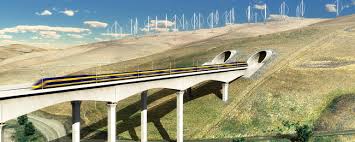
Though having plowed this political opening with his State of the State address, Newsom vowed to fight Trump’s clawback threat, holding that Congress had earmarked this money for California’s rail project and wasn’t about to give it back—so the public policy battle is on, full bore.
Still, the state’s entire HSR project is further bogged down in the morass of land acquisition, local regulations and an unending freight train of litigation—from environmental review and regulation to deep-pocket NIMBYism.
Nevertheless, Governor Newsom says he will also proceed with environmental work to facilitate eventual Bay Area to L.A. Basin expansion, with dedicated rather than existing tracks, and garner the further funding necessary to ‘get California’s HSR right’.
Slow Loco-motion.
These confusion and backbiting squabbles have sidetracked the California project since its High-Speed Rail Authority steamed in some 23 years ago, promising this smart, efficient transportation statewide. Contemporaneously, China has constructed a 16,000-mile HSR system, while other Asian and European systems have grown and thrived. Now Washington State champions an international HSR route between Vancouver, B.C. and Seattle/Portland. So make a firm decision, guv, before High-Speed California becomes a third rail for everyone concerned.
Over the long haul, it remains to be seen whether the HSR project progresses from here: namely, if the Golden State ‘that knows how’ builds out its 2008 vision, and to where or nowhere. Which is precisely what Vamigré will be tracking along the way…
On and Off the Rails.
For a sense of this HSR project’s fate, a comparative glance at similar efforts elsewhere in the U.S. seems in order:
In Texas, for instance, a privately funded (per Texas Central Partners) Bullet Train between Houston and Dallas has recently been environmentally cleared by D.O.T.’s Federal Railroad Administration. The Texas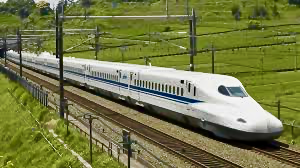 Bullet Train will deploy Japanese N700 Tokaido Shinkansen technology, and this 240-mile electrified line will link the Lone Star state’s two largest cities in 90 minutes, at speeds upwards of 205 m.p.h.
Bullet Train will deploy Japanese N700 Tokaido Shinkansen technology, and this 240-mile electrified line will link the Lone Star state’s two largest cities in 90 minutes, at speeds upwards of 205 m.p.h.
Moreover, a partnering agreement has been reached with Amtrak for mutual ticket/reservation access, and transfer/ thru travel to the interstate rail system’s established routes. The bullet line promises to roll out Houston-Dallas service every 30 minutes, 5 a.m-11:30 p.m. starting in 2019, to ‘decrease Texas traffic and greatly expand connectivity’.![]()
Brightline (2/7/20): A Sun-Drenched Future…
Now Florida has already established private-sector high-speed intercity service between West Palm 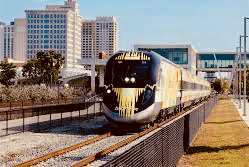 Beach and Fort Lauderdale. Opened this past January, the Brightline is owned, operated and maintained by All Aboard Florida/Florida East Coast Industries, which extended service to Miami in May and plans to expand to Orlando/Cocoa by 2021.
Beach and Fort Lauderdale. Opened this past January, the Brightline is owned, operated and maintained by All Aboard Florida/Florida East Coast Industries, which extended service to Miami in May and plans to expand to Orlando/Cocoa by 2021.
This, though (former) Republican Governor Rick Scott scuttled any further taxpayer funding for such route expansion. Yet plans are on the drawing boards for HSR networking up and down the Sunshine State, over to Tallahassee. Using diesel-electric trains on shared freight corridor tracks, eventual travel times between Miami and Orlando will be under three hours at 186 m.p.h.. The service has posted an $87m loss in 1-3Q 2018, but brightening Brightline’s picture is news that Richard Branson has made a 20% investment in the “Higher Speed Ride”.
Already haven gained vast rail experience in Virgin Train Britain, his Virgin Group has convinced All Aboard Florida to rename the line Virgin Trains USA, though it remains to be seen whether the high-flying billionaire is in this particular HSR venture for the long haul. But one indicator is that investor demand to keep VT USA a private company is so strong, that the line has derailed its planned IPO, with a Las Vegas to Los Angeles route in the works…
…Or Death Row?
![]() Two years into its Florida operation, Brightline is being called by some critics “the nation’s deadliest railroad.”
Two years into its Florida operation, Brightline is being called by some critics “the nation’s deadliest railroad.”
The high-speed train runs at speeds of nearly 80 m.p.h. on its 70-mile stretch of South Florida. More than 40 people have been killed along its Miami-West Palm Beach tracks and/or rail crossings—an average of one person per month in a car, on a bike or on foot.
So Brightline has been holding a public education campaign that warns against people 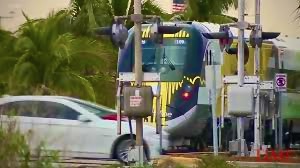 taking unnecessary chances by darting across tracks, or driving around crossing gates. The rail line claims that 75% of these incidents can be attributed to drugs or suicide attempts, “…affecting every railroad across the country.”
taking unnecessary chances by darting across tracks, or driving around crossing gates. The rail line claims that 75% of these incidents can be attributed to drugs or suicide attempts, “…affecting every railroad across the country.”
However the state of Florida’s Department of Transportation says suicides cause roughly 30% of all rail fatalities, and activists such as the Alliance for Safe Trains call Brightline’s figures “baloney.” AST wants closer government scrutiny and regulation of the privately held rail line, asserting that Brightline leads the U.S. in right-of-way fatalities because its trains run so fast through populous communities, on Florida East Coast Railway tracks long used solely by slower freight trains.
The activists also call on the state to legislate for stronger safety standards regarding private railroads, and more pedestrian gates, bridges and fencing all along the route to greatly lessen these deaths.
Brightline estimates that such fencing would prohibitively cost over $200,000 per mile, and any more regulation could stifle its privately funded ($4b) effort to expand the service northward to Orlando, as it continues working to lure drivers off Florida’s crowded highways.
So Vamigré will track this deadly legislative row as it chugs through the Sunshine State’s capital, Tallahassee, to see whether it highballs forward or brakes and stalls to an end of the line. (MTC…)
![]()
Rail Ties That Bind.
Otherwise, the Northeast Corridor has been the HSR Petri dish, and still rules the rails. Initiated as the ‘American Flyer’ in the early 1990s, the renamed Acela (excellence/acceleration) service between Washington D.C. and Boston replaced Metroliner in December, 2000. AE has led the way for advanced 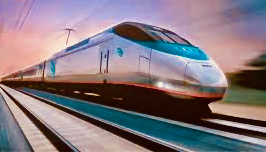 passenger rail travel in the U.S. ever since. An early adopter of Bombardier’s Alstom TGV technology, Acela Express has long been Amtrak’s flagship route for the nation.
passenger rail travel in the U.S. ever since. An early adopter of Bombardier’s Alstom TGV technology, Acela Express has long been Amtrak’s flagship route for the nation.
Though operating largely on older freight routes, electric powered Acela trains can attain peak speed in two stretches of the 457-mile line (363 mi. of it for Acela), between Massachusetts and Rhode Island. Therein, the trainsets can hit upwards of 150 m.p.h. today, utilizing tilting technology to safely control lateral centripetal forces around roadbed curves.
So Acela Express offers a soupçon of high-speed service to come—a smooth, quiet ride in spacious leather seating, with generous overhead storage. No TSA ordeals, FCFS side by side recliners or two + two opposed with a center table: Acela is hardly a cheap ticket, and the food service could be better. But that doesn’t much deter an 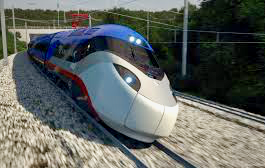 ever-growing ridership along the NEC, weary of the short haul airline shuttles and all the hassles and headaching baggage along for that bumpy ride.
ever-growing ridership along the NEC, weary of the short haul airline shuttles and all the hassles and headaching baggage along for that bumpy ride.
What’s more, Amtrak has announced even sleeker, swifter new Amelia Liberty trains set for introduction in 2021.
Beyond that, USHSR next plans route expansion in the heartland: between Chicago and St. Louis, up to Milwaukee and Minneapolis. A southern line from Atlanta to Birmingham is also mapped out, with a Portland to Seattle run aimed toward 2020.
By 2025, HSR service is envisioned for all over the Great Lakes region and down the Eastern Seaboard from Portland, Maine to Savannah. Hubbing out of St. Louis is on the drawing boards for 2030, linking Kansas City out to Salt Lake City and beyond.
In all, this four-stage expansion will create a fully integrated, multi-layered nations HS rail system, spiderwebbing coast to coast with 220 m.p.h. lines.
Railin’ at the Railers and Derailers.
Point being, today’s detractors can carp all they want about construction costs, iffy public support/funding, property rights encroachment, and dubious sustained usage and economic viability outside the North East Corridor. They argue that the compact networks of Japan and Europe will not wash in such a large, wide-open U.S. partial to its automobile culture and flying convenience—however testy and troublesome those 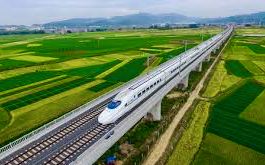 modes and experiences have become.
modes and experiences have become.
For high-speed rail promises a clean, carbon solution and alternative to the present chaos and congestion of travel as we know it today. Just as naysayers fought the Golden Gate Bridge of the 1930s and interstate highway system of the Eisenhower 1950s, the smarter move is to buck up, support the nigh on inevitable now, and enjoy the HSR future as it rolls in comfortably on schedule…which of course Vamigré will be monitoring closely. All aboarrrrd!
